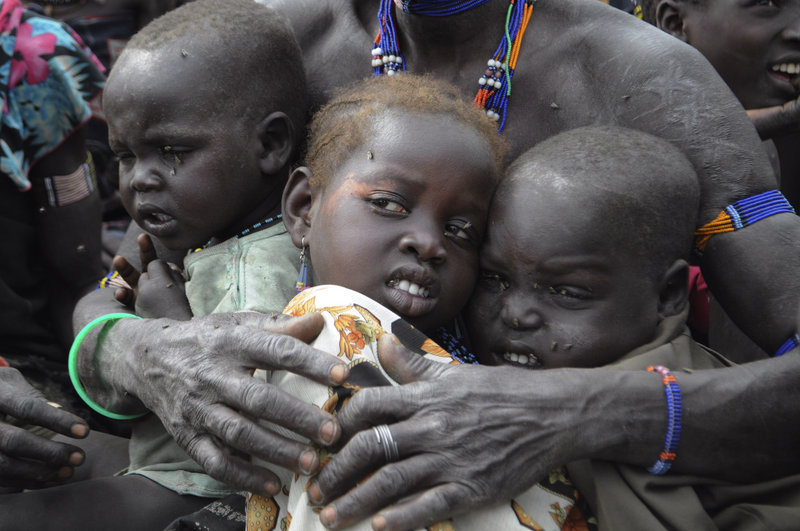WAU, South Sudan — Teresa Adut Akol’s new home is a small patch of concrete floor in a railway station outside this town. She shares the space with her eight children and stacks of their belongings, surrounded by dozens of other families whose return to South Sudan also has stalled here.
Millions of people fled the south during Sudan’s decades-long civil war. Since a peace agreement in 2005 and South Sudan’s independence last summer, many have returned, melting back into the areas they left years ago.
But thousands of others have been unable or unwilling to reclaim their traditional homes. Many are stuck at transit sites across South Sudan — train stations, ports and temporary camps — with limited access to food and medical care.
The situation is especially tenuous for women like Akol, who led their families back south.
The approaching rainy season will make the situation worse, officials say, creating a potential humanitarian crisis as the world’s newest nation faces a series of challenges.
Food shortages have become widespread, and ethnic conflict has flared in recent months.
And the government’s decision in January to shut down oil production — which accounts for 98 percent of its revenue — following a feud with Sudan over transit fees will make confronting these issues even more difficult.
Meanwhile, renewed tension and fighting along the border between Sudan and South Sudan have brought new risks to potential returnees seeking to make the journey back to the south.
‘GLAD TO BE BACK HOME’
But the hardships haven’t dampened Akol’s eagerness to begin building a life in this new country.
“Even if I stay in the bush or wherever, I’m glad to be back home,” she said.
Akol was one of the millions of southerners caught up in the war.
She fled north, where she met her husband, another displaced southerner, and started a family. Their oldest child, Martha Chol, said she grew up listening to her parents vow that they would move back to the south.
That day came in December, five months after South Sudan celebrated its independence. A trip by barge and bus ended at the railway hangar in Wau, a bustling town along the Jur River.
Without her husband, who stayed behind waiting for some money he was owed, Akol said she is unsure how to claim land in his family’s traditional area.
Hers has been a common problem for many of the women returning to the south, said Gregory Norton, program director for the Norwegian Refugee Council.
While the transitional constitution allows women to own land, traditional customs of male-only land ownership dominate in some areas.
Akol can appeal to local officials or higher authorities in Juba, the capital, but she said she can’t afford to leave her children and is not convinced that she would be successful if she tried.
Other returnees, used to life in urban areas in the north with consistent access to water, markets and schools, have refused to leave the transit sites for their traditional — and often undeveloped — villages.
SOME STAY AT TRANSIT SITES
“They basically said, ‘There’s nothing in my village; why would I go?’ ” said Maureen Murphy, an officer with the American Refugee Committee.
Instead, they hope the government will find them a place near a city, where they can start businesses instead of farms.
But that process has been “incredibly slow,” said Samantha Donkin, a spokeswoman for the International Organization for Migration.
As they wait, there is little for them to do except watch their resources dwindle. Most of the adults at the Wau railway station have given up on looking for work.
Families are living off three-month food rations they received from IOM or are selling off the things they brought, such as beds, mattresses and bags of sugar.
The rainy season, which can last six months or longer in some areas, will soon turn unpaved roads to mud, making it difficult for supplies to move and exacerbating the food shortages, according to the World Food Program.
The scarcity will be particularly acute for people at the transit sites, who don’t have communities or families to help them.
“There’s a potential humanitarian crisis,” Radhika Coomaraswamy, the United Nations’ special representative for children and armed conflict, said after a visit to a returnee camp in the north last month. “We really need to mobilize resources in case the numbers increase.”
Meanwhile, the fate of an estimated 700,000 South Sudanese in the north remains unclear. The two governments had agreed in March that southerners who were registered by last Sunday could obtain residency or work permits in the north, or else they could repatriate to the south.
But plans for the leaders of the two countries to sign the accord were aborted amid renewed fighting, and only a handful of the southerners have been registered.
Andrew Green is reporting from South Sudan on a fellowship from the International Reporting Project.
Send questions/comments to the editors.



Success. Please wait for the page to reload. If the page does not reload within 5 seconds, please refresh the page.
Enter your email and password to access comments.
Hi, to comment on stories you must . This profile is in addition to your subscription and website login.
Already have a commenting profile? .
Invalid username/password.
Please check your email to confirm and complete your registration.
Only subscribers are eligible to post comments. Please subscribe or login first for digital access. Here’s why.
Use the form below to reset your password. When you've submitted your account email, we will send an email with a reset code.